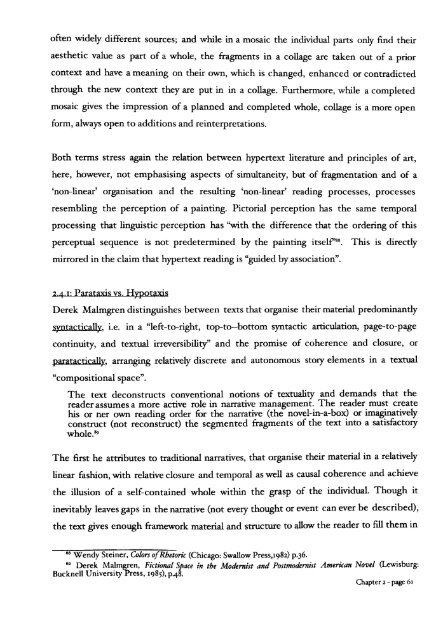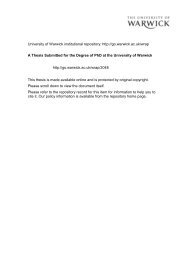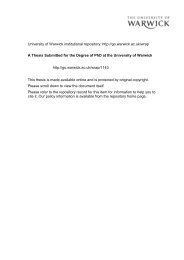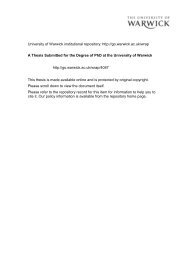From Page to Screen - WRAP: Warwick Research Archive Portal ...
From Page to Screen - WRAP: Warwick Research Archive Portal ...
From Page to Screen - WRAP: Warwick Research Archive Portal ...
You also want an ePaper? Increase the reach of your titles
YUMPU automatically turns print PDFs into web optimized ePapers that Google loves.
often widely different sources; and while in a mosaic the individual parts only find their<br />
aesthetic value as part of a whole, the fragments in a collage are taken out of a prior<br />
context and have a meaning on their own, which is changed, enhanced or contradicted<br />
through the new context they are put in in a collage. Furthermore, while a completed<br />
mosaic gives the impression of a planned and completed whole, collage is a more open<br />
form, always open <strong>to</strong> additions and reinterpretations.<br />
Both terms stress again the relation between hypertext literature and principles of art,<br />
here, however, not emphasising aspects of simultaneity, but of fragmentation and of a<br />
'non-linear' organisation and the resulting 'non-linear' reading processes, processes<br />
resembling the perception of a painting. Pic<strong>to</strong>rial perception has the same temporal<br />
processing that linguistic perception has "with the difference that the ordering of this<br />
perceptual sequence is not predetermined by the painting itself?", This is directly<br />
mirrored in the claim that hypertext reading is "guided by association".<br />
2.4.1: Parataxis vs. Hypotaxis<br />
Derek Malmgren distinguishes between texts that organise their material predominantly<br />
syntactically, i.e. in a "left-<strong>to</strong>-right, <strong>to</strong>p-<strong>to</strong>-bot<strong>to</strong>m syntactic articulation, page-<strong>to</strong>-page<br />
continuity, and textual irreversibility" and the promise of coherence and closure, or<br />
paratactically, arranging relatively discrete and au<strong>to</strong>nomous s<strong>to</strong>ry elements in a textual<br />
"compositional space".<br />
The text deconstructs conventional notions of textuality and demands that the<br />
reader assumes a more active role in narrative management. The reader must create<br />
his or ner own reading order for the narrative (the novel-in-a-box) or imaginatively<br />
construct (not reconstruct) the segmented fragments of the text in<strong>to</strong> a satisfac<strong>to</strong>ry<br />
whole."<br />
The first he attributes <strong>to</strong> traditional narratives, that organise their material in a relatively<br />
linear fashion, with relative closure and temporal as well as causal coherence and achieve<br />
the illusion of a self-contained whole within the grasp of the individual. Though it<br />
inevitably leaves gaps in the narrative (not every thought or event can ever be described),<br />
the text gives enough framework material and structure <strong>to</strong> allow the reader <strong>to</strong> fill them in<br />
88 Wendy Steiner, Colors ofRhe<strong>to</strong>ric (Chicago: Swallow Press,1982) P.36.<br />
69 Derek Malmgren, Fictional Space in the Modernist and Postmodernist American Novel (Lewisburg:<br />
Bucknell University'Press, 1985), P48.<br />
Chapter 2 - page 61





